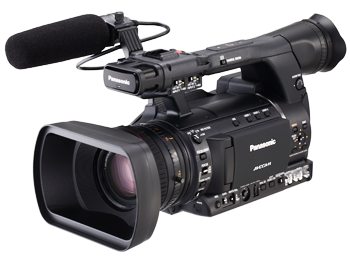
High-Quality, Full-HD Progressive/Slow-/Quick-Motion Recording*1
Professional Imaging with High-Powered Zooming, High Sensitivity and Advanced Functions — The AVCCAM
Memory Card Camera Recorder
This high-end model of the AVCCAM Series provides Full-HD
progressive and slow/quick-motion recording, high-quality
LPCM audio, and HD SDI output.
The AG-AC160A and AG-AC130A Memory Card Camera Recorders offer a host of advanced functions. The lens and both camera and recorder sections have been significantly evolved by incorporating cutting-edge technologies. The 22x zoom lens has a field of view that approaches that of an interchangeable lens, together with the operability required for professional use, with features like high-speed auto focus and a full complement of focus assist functions.

Combining the high-sensitivity, low-noise, high-resolution 1/3-type 2.2-megapixel U.L.T. (Ultra Luminance Technology) MOS image sensor and professional AVCHD PH mode ensure high-quality Full-HD 1920 x 1080 recording. The AG-AC160A and AG-AC130A also feature a DV (SD)*2 recording mode, further expanding their operability.
In addition, the AG-AC160A comes with advanced functions like a PS mode for recording Full-HD progressive (1080/59.94p, 50p) images,*3 high-quality LPCM recording, HD slow/quick-motion recording,*1 HD SDI output compatibility, and a switchable 59.94Hz/50Hz mode. With their superb cost-performance, the AG-AC160A and AG-AC130A support a wide range of needs, from professional uses to image production and news gathering.
*1: AG-AC160A only. Playback in 1080/60p mode not possible. 720p VFR not supported. Class 6 or higher SDXC/SDHC/SD Memory Card required for VFR recording.
*2: DV files are recorded onto an SD Memory Card.
*3: HD SDI and HDMI output 1080/59.94i or 50i images.
A Lens, Image Sensor and Recording Modes Designed for High-Quality Images

Broadcast-Grade Performance with a 22x Zoom Lens and 2.2-Megapixel U.L.T. Image Sensor
Packed with Panasonic Optical Technology
 The high-performance zoom lens was developed specifically for professional HD video production. While inheriting the wide-angle capabilities of the DVX and HMC Series, it adds the same level of operating ease as you’d expect from an interchangeable lens model for broadcasting and other professional uses. Combining 18 lens elements in 12 groups, this advanced lens unit further adds a UHR (Ultra High Refractive) glass element, a low dispersion element and aspherical lenses. In short, it raises resolution with the newest optical technologies available. Zooming from 28mm to 616mm (35mm equivalent), this 22x zoom lens covers a wide field of view, from wide-angle to telephoto, without a conversion lens.
The high-performance zoom lens was developed specifically for professional HD video production. While inheriting the wide-angle capabilities of the DVX and HMC Series, it adds the same level of operating ease as you’d expect from an interchangeable lens model for broadcasting and other professional uses. Combining 18 lens elements in 12 groups, this advanced lens unit further adds a UHR (Ultra High Refractive) glass element, a low dispersion element and aspherical lenses. In short, it raises resolution with the newest optical technologies available. Zooming from 28mm to 616mm (35mm equivalent), this 22x zoom lens covers a wide field of view, from wide-angle to telephoto, without a conversion lens.
Three Manual Rings — Zoom, Focus, Iris
The lens unit is provided with three rings — a mechanical (cam-driven) zoom ring, a focus ring, and an iris ring. The positive operating feel of these rings gives you manual control similar to an interchangeable lens.
Optical Image Stabilizer, Digital Zoom, and ND Filter
• Hand-shake correction with the Optical Image Stabilizer (OIS).
• Digital Zoom function. It can be assigned to an user button and close up to 2x, 5x, and 10x. In combination with the optical zoom, this function provides a telephoto capability up to 220x.
• Four-position (OFF, 1/4 ND, 1/16 ND, 1/64 ND) optical neutral density filter wheel.
High-Sensitivity, 2.2-Megapixel, Low-Noise U.L.T. Image Sensor and Optimized Signal Processing Circuit

The AG-AC160A/AC130A feature the same Ultra Luminance Technology (U.L.T.) 1/3-type 2.2-megapixel 3MOS image sensor that is incorporated in our shouldertype P2HD camera recorders.
This advanced image sensor is set to maximize the performance of the lens and signal processing circuit under standard shooting conditions.
High-Quality Image Processing and Image Quality Settings
for High-End Image Production

18 bit Digital Signal Processor
The AG-AC160A/AC130A incorporate a high-performance 18 bit DSP that handles image rendering processes such as gamma and various detail enhancement functions with exceptional precision.
Dynamic Range Stretch (DRS)

In scenes with mixed contrast, such as when panning from indoors to outdoors, the DRS function automatically suppresses blocked shadows and blown highlights. A gamma curve and knee slope are estimated to match the contrast of each pixel, and applied in real time. When dark, bright, and intermediate shades are all contained in the same scene, this produces excellent gradation for each shade and minimizes blocked shadows and blown highlights.
3-Position Gain Selector plus 24 dB / 30 dB Super Gain
There is a 3-position gain selector, with L, M and H settings. To each setting you can assign a gain value from 0, +3, +6, +9,+12, +15 and +18 dB. There is also a Super Gain such as +24 dB and +30 dB.*
*+24 dB and +30 dB can be assigned to an user button only.
7-Mode Gamma for Richer Gradation

Drawing on technologies developed for the VariCam, Panasonic has equipped the AG-AC160A/AC130A with advanced gamma functions that address seven different shooting scenarios, including two Cine-Like Gammas.

Other Camera Image Settings
• Matrix setting including a Cine-Like mode.
• Adjustable H detail level, V detail level, detail coring and skin tone detail.
• Adjustable chroma level, chroma phase, color temp and master pedestal.
• Knee point settings: Auto, Low, Mid and High.
• White balance: Three values (A/B/Preset) of white balance with an auto tracking white function. The Preset can be set to 3200 K, 5600K and VARIABLE which ranges between P2.4K and P9.9K.
Switch Between DV and AVCHD PH/PS Mode for High Image and Sound Quality
High Quality, Multi-Format Professional AVCHD PH Mode
AVCHD/DV The AG-AC160A/AC130A use the AVCHD recording format and also support the high-image-quality PH mode. AVCHD complies with MPEG-4 AVC/H.264 High Profile, the latest motion picture compression technology. Boasting more than twice the compression efficiency of MPEG-2 systems (such as HDV), this advanced video file format delivers superb image quality and low data rates.
The PH mode was developed exclusively for AVCCAM and records 1920 x 1080 Full-HD images. The AVCHD PH mode is also compatible with multiple HD formats, such as 1080/59.94i, 1080/29.97p, 1080/23.98p and 720/59.94p. (See the chart below.)
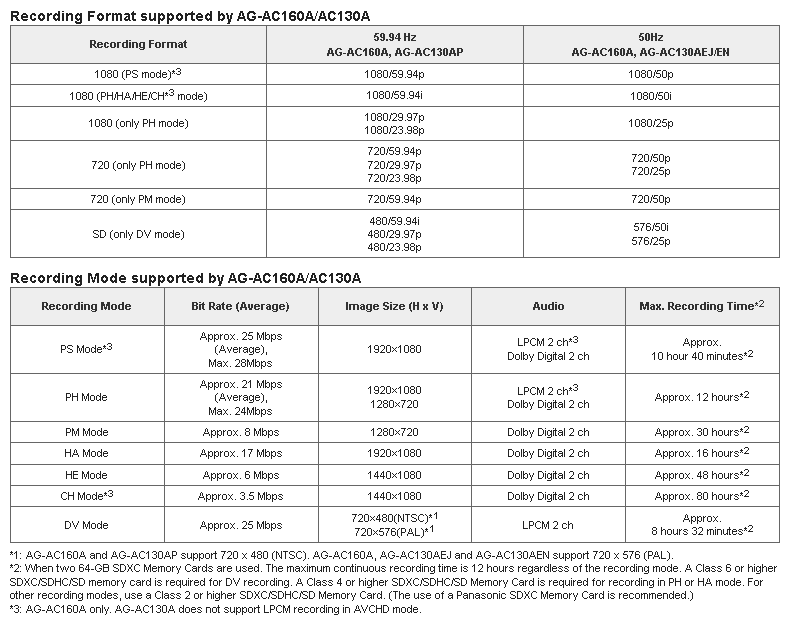
PS Mode for 1080 Progressive Recording
The AG-AC160A also complies with the AVCHD Ver.2.0 (AVCHD Progressive) standard in its PS mode (maximum bit rate: 28 Mbps) for recording Full-HD progressive (1080/59.94p, 50p*) images.
*HD SDI and HDMI output 1080/59.94i, 50i image signals.
LPCM Recording for High-Quality Sound
The AG-AC160A supports uncompressed 16-bit LPCM 2-channel digital audio recording with PH mode for high-quality sound. Other modes and the AG-AC130A employ Dolby Digital 2-channel audio recording.
59.94Hz/50Hz Switchable
The AG-AC160A lets you select 59.94 Hz or 50 Hz to support video production systems used around the world.
DV Recording Mode Supported
Records SD video into a DV-format file* (AVI Type 2) for added flexibility. Standard DV output (IEEE 1394) lets you ingest files to a PC or Mac.
*Class 6 or higher SDXC/SDHC/SD Memory Card required. The DV-format file made by the AG-HMC80 Series is not fully compatible with the AC160A/130A. Use the same model of camera recorder that will be used to play back the DV-format file.
Dual Slots Enable Relay and Simultaneous Recording
Dual memory card slots are featured. Relay recording*1 lets you seamlessly record images onto two memory cards consecutively, and simultaneous recording*2 records the same images onto two different memory cards to increase reliability. The slot to be used can be switched during normal recording.
*1: The AVCHD’s maximum consecutive recording length is 12 hours. This cannot be extended even by using the relay function.
*2: Simultaneous recording cannot be combined with relay recording, VFR recording or interval recording. Also, Rec Check and Last Clip Delete will not operate during simultaneous recording.
SDXC/SDHC Memory Card Supported
The SDXC Memory Card is a large-capacity data storage device.  The memory card features a high capacity of up to 64 GB. The AG-AC160A/ AC130A can also use SDHC and SD Memory Cards. The high-performance, highly reliable
The memory card features a high capacity of up to 64 GB. The AG-AC160A/ AC130A can also use SDHC and SD Memory Cards. The high-performance, highly reliable
professional SDHC Memory Card is ideal for recording with a Panasonic AVCCAM.
* Class 6 or higher SDXC/SDHC/SD Memory Card required for PS mode (AG-AC160A), VFR (AG-AC160A), and DV mode recording. Class 4 or higher SDXC/SDHC/SD Memory Card required for PH/HA mode recording. Use a Class 2 or higher SDXC/SDHC/SD Memory Card for PM/HE mode recording. (A Panasonic SDXC Memory Card is recommended.)
Wide-Ranging Recording Functions Including Full-HD Slow/Quick Motion
Variable Frame Rate —Full-HD (1080p) VFR Recording*
The Variable Frame Rate (VFR) function was inherited from the Panasonic VariCam, which is widely used for producing movies, TV series and TV commercials. It creates a wide range of film-camera-like images, such as overcranking for slow-motion and undercranking for quick-motion effects. The AG-AC160A’s VFR function* supports Full-HD (1920 x 1080) progressive mode.
*AG-AC130A does not support VFR function. The VFR function can be selected at PH mode only. It doesn’t support 1080/60p, 50p playback and 720p mode. For VFR recording, class 6 or faster SDXC/SDHC/SD memory card is required.

Normal cinematic shooting (at 24 fps, 25 fps or 30 fps) refers to the same rate as used in film cameras.  The AG-AC160A can record at 24 fps. Note that 25 fps and 30 fps are the standard frame rates used in producing TV commercials, music clips and video media.
The AG-AC160A can record at 24 fps. Note that 25 fps and 30 fps are the standard frame rates used in producing TV commercials, music clips and video media.
Overcranking (higher-speed shooting) produces a slow-motion effect. This is especially effective for high-action scenes like car chases or crashes, or to create a dramatic impact in a scene.  For example, when a scene is shot at 48 fps and played at 24 fps, a slow-motion effect of 1/2x is attained.
For example, when a scene is shot at 48 fps and played at 24 fps, a slow-motion effect of 1/2x is attained.
Undercranking (lower-speed shooting) gives you a quick-motion effect. This technique can be combined with a warp-speed effect to give special emphasis to flowing water, fast-moving clouds, etc. 
For example, when a scene is shot at 12 fps and played at 24 fps, a quick-motion effect of 2x is attained.
Versatile Solid-State Recording Functions
• Interval Rec: Records one frame at a time in set intervals (1 sec., 10 sec., 30 sec., 1 min., 2 min.). Only in 1080/24p and 25p mode.
Audio recording not possible (AVCHD mode only).
• Pre-rec: While in standby mode, the camera recorder can continuously store, and subsequently record, up to approximately 3 seconds. This helps to ensure that you always get the shot you want.
• Shot mark: Allows convenient OK or NG marking, and can be added to each clip during or after recording.
• Index: Scenes can be marked with up to 100 index flags per clip(AVCHD mode only).
• Rec check: You can check the end of the most recently recorded clip with one-touch ease.
• Last clip delete: Only the most recently recorded clip is deleted with one-touch ease.
• Time stamp: The date and time can be stamped onto recorded images. Commonly used for recording evidentiary depositions and procedures.
SMPTE Time-Code Recording and Synchro Function
The built-in SMPTE time-code generator lets you select the Drop Frame/Non-Drop Frame and Free Run/Rec Run modes and preset. User bits are also provided. Connecting two cameras with a TC preset in/out (video out) connector allows the slave camera to synchronize with the master camera.*
*After synchronization, each camera’s time-code runs separately and cannot be guaranteed to match precisely.
Versatile Assist Functions Support Comfortable Image Acquisition
Versatile Focus Assist

Focus-in-red / Expand FunctionThe AG-AC160A/AC130A feature the Turbo-Speed One-Push Auto-Focus to focus an object in less than 0.5 seconds*. The focus bar indicates the focus level, the focus-in-red display shows the focus area, and a expand function enlarges the center of the displayed image. These three display functions help you to focus
quickly and accurately. A face detection function is also provided, and area auto focus and area auto iris are possible.
*Focusing time may vary depending on shooting conditions and object.
Area Focusing and Area Iris Functions

Area FunctionUsing the function knob (cursor key), you can select a desired area in the frame and set it as a target zone for focusing, iris adjustment and YGET (brightness measurement). This increases shot-composing flexibility. In addition to the above three modes, there are two other modes: simultaneous focusing/iris adjustment and simultaneous focusing/YGET.
High-Quality Color Viewfinder and LCD
The AG-AC160A/AC130A’s color EVF uses a 11.43 mm (0.45 inches), approximately 1,226,000 dot-equivalent (852 × 480 × 3 [RGB]) LCOS(liquid crystal on  silicon) display panel. It delivers bright, detailed, high-resolution images and a high response speed. The AG-AC160A/AC130A’s LCD monitor has a 87.63 mm (3.45 inches), approximately 921,000-dot (1920 × 480) high-resolution panel.
silicon) display panel. It delivers bright, detailed, high-resolution images and a high response speed. The AG-AC160A/AC130A’s LCD monitor has a 87.63 mm (3.45 inches), approximately 921,000-dot (1920 × 480) high-resolution panel.
Simplified Waveform and Vectorscope Display
Waveform/VectorscopeThe AG-AC160A/AC130A have Waveform and Vectorscope Display functions for the captured video signal on the LCD monitor.
Scene File / User File
Use the Scene dial to retrieve an instant set of shooting conditions. Six preset files are provided, and you can change any of the six file
names and their settings as desired. One set can be stored internally in the AG-AC160A/AC130A, and four sets on an SD Memory Card.
One file with camera setting values can also be stored internally, and four files on an SD Memory Card.
Scene File Description
Three User Buttons
Three user buttons are provided for one-touch operation of frequently used functions. All buttons are located on the LCD monitor side of the body. Each button can be assigned with any of the following 16 functions: INH, FACE DETECT, WFM, EVF DTL, D.ZOOM, DRS, S.GAIN, ATW, ATW LOCK, SHOT MARK, INDEX, LAST CLIP, BACKLIGHT, SPOTLIGHT, BLACKFADE, WHITEFADE.
Professional Specs Including a New Design for Added Mobility and HD SDI Output
New, Stylish Design Also Boosts Mobility

Even with the high-powered zoom lens, the integrated camera and recorder sections are compact and stylish. Shifting the handle grip and LCD position forward (toward the lens) has improved the weight balance and visibility for handheld shooting, enabling a comfortably wide view. The magnesium alloy die cast chassis also excels in both ruggedness and durability.
Low-Angle Shots and Interviews
• The upper part of the handle grip contains both the Rec Start/Stop button and a lens zoom speed control (three speeds). This design assures easy shooting even at low angles.
• The LCD Monitor Mirror mode is convenient when shooting self-contained interviews.
SDI (24PsF) Output and Auto Rec*
The AG-AC160A is equipped with an HD/SD SDI output terminal for outputting HD signals, including 1080/24PsF, or down-converted SD
video signals (selectable from the menu). The terminal also supports Auto Rec to enable backup recording in link with Rec Start/Stop
when a Panasonic recorder equipped with the same function, such as the AG-HPD24, is used. Embedded audio is also supported.
*AG-AC130A does not have SDI OUT terminal.
XLR Input for Pro-Quality Audio

In addition to the internal highperformance stereo microphone, the AG-AC160A/AC130A come equipped with two-channel XLR audio input terminals with a 48-V phantom power supply. The internal microphone, external microphone or line input can be selected for each channel. Large, easy-to-use level dials are also provided.
HDMI Digital HD Output Terminal
The AG-AC160A/AC130A are equipped with a next-generation HDMI (High Definition Multimedia Interface) output terminal for digital transferring of high-quality HD video and audio signals.
Down-Converted SD Video Output

The AG-AC160A/AC130A have an internal down-converter so they can output SD (480/576) signals from SDI, HDMI* or VIDEO OUT. The 16:9/4:3 aspect conversion mode can be selected from three types (side crop, letterbox, squeeze).
*Down-converted signal on HDMI is 480p or 576p only.
Designed for Professional Use
• Marker/Grid: Various markers and grids can be displayed on the LCD monitor/viewfinder.
• Mode check: Displays a list of the camera settings on the viewfinder and monitor.
• Zebra: Select any two levels from among 50% to 105%, in 5% steps.
• Color bar: Outputs a color bar signal and test tone.
• Remote terminal: Enables remote operation of iris, focus, Rec Start/Stop and index functions.
• USB 2.0: Type mini-B USB port for connection of a PC in DEVICE mode.
• Tally lamps: Provided on the unit’s front and rear.
The AVCCAM series Enables a Speedy, Efficient Image Production
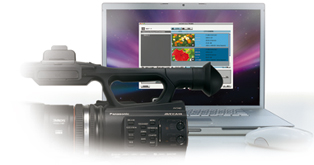
The AVCCAM Series Makes Video Packaging and Internet Distribution*1 Smooth and Easy.
The tapeless design means lower total costs, and unlike tape, AVCHD files require no digitizing*2 and can be directly and quickly transferred*3 to storage in a Windows PC or Mac. This makes it easier to use motion images in IT applications*4 like content production, internet distribution*1 and source material archiving.
AVCHD’s direct editing also saves time and effort in TV program production. AVCHD means lower costs for both media and equipment maintenance.
*1: To distribute AVCHD files on the web, you may need to use a video distributing service that is operated by other web publishers supporting AVCHD. For real-time web distribution, a real-time video encoder that is supplied by other manufacturers may be required.
*2: Editing may require conversion to an intermediate codec, depending on the editing software. The conversion speed varies depending on the hardware specifications of the Windows PC or Mac, the software used for converting, and the file format being converted.
*3: Maximum speed: 22 MB/s (Using a Class 10 SDHC Memory Card. Speed depends on the hardware specifications of the Windows PC or Mac.) Some computers may not recognize the SDXC/SDHC Memory Card. If that occurs, use an SDXC/SDHC Memory Card Reader.
*4: AVCHD-compatible software is required. The minimum system requirements for using the software must also be satisfied.
AVCHD Nonlinear Editing
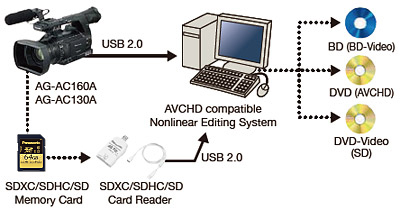
Compatibility with existing HD editing environments, AVCHD files can be transferred at high speed by using the USB 2.0 interface to connect the AVCCAM series or an SDXC/SDHC/SD Memory Card reader to a Windows PC/Mac. This dramatically improves productivity when compared with the time-consuming task of digitising.
![]()
DV Nonlinear Editing
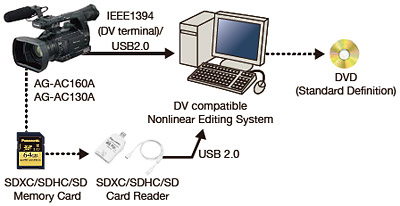
The AG-AC160A/AC130A have an IEEE 1394-compliant DV (6-pin) output terminal. Simply connect it to an existing DV nonlinear editor for transmitting its DV compression stream output.
*File transfers are not supported.
*AVCHD files can not be converted to DV files and output via IEEE1394 (DV terminal).
Precautions for Using the SDXC Memory Card
•The SDXC Memory Card can be used for products that display the SDXC logo mark either on the product itself, or in the User’s Manual. It cannot be used with products that are only compatible with SDHC/SD Memory Cards.
•How to confirm SDXC compatibility: Confirm compatibility by looking for the SDXC logo mark on the product or in the User’s Manual, or check the information provided by the product manufacturer.
•When using the SDXC Memory Card with a computer: For a computer with Windows 7 OS, use the SDXC Memory Card via an SDXC-compatible USB reader/writer, or connect the SDXC Memory Card to an SDXC-compatible product via a USB terminal. If you want to use the SDXC Memory Card in a direct slot, be sure to check the information provided by the manufacturer for the computer that you plan to use, and follow the instructions therein.
•UHS-I (Ultra-High Speed I) is a speed class for SD Memory Cards. UHS-I compatible memory cards can be used in the AG-AC160A/AC130A as SD Speed Class 10 cards.
A Host of Software to Support Production
AVCCAM Viewing Function of P2 Viewer Plus (for Windows/Mac, Free Download)
The New P2 Viewer Plus software includes the ability to view AVCCAM files. AVCCAM files can be played from an SDHC/SDXC memory card or hard disk and saved to a PC (hard disk). Files can also be copied to an SDXC/SDHC memory card.
AVCCAM SD Card File Recovery (for Windows/Mac, Free Download)

The AVCCAM SD Card file recovery is software for repairing the file which was erased or formatted accidentally. It supports SDXC/SDHC/SD memory card.
*This software can only be used with AVCHD, DV and JPEG clips recorded with a Panasonic AVCCAM series camera.
*Note that it will not always be possible to repair the files using this software.
AVCCAM Importer (for Mac, Free Download)

AVCCAM Importer is a software for Apple Final Cut Pro 7 to enable direct editing of AVCHD* “.mts” files without conversion. Since AVCCAM Importer is a plug-in component for Apple QuickTime, QuickTime Player can play AVCHD “.mts” files and other software based on QuickTime Framework can also handle AVCHD “.mts” files directly after installation of AVCCAM Importer on a Mac.
*AVCCAM Importer supports the AVCHD files produced by AVCCAM products only.
AVCCAM Restorer (for Windows/Mac, Free Download)
The AVCCAM Restorer is software for restoring inconsistencies in video data recorded on an SDXC/SDHC/SD Memory Card.
*This software can only be used with AVCHD clips recorded with a Panasonic AVCCAM series camera.
*Note that it will not always be possible to restore the data using this software.
*This software targets recorded data that has been damaged for restoration. It is not capable of performing processing to restore deleted data.
